Last updated: January 16, 2018
Article
Economic History
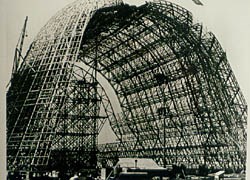
Photograph from National Register of Historic Places collection
Prior to World War II the economy of Santa Clara County was tied to agriculture. By 1939 San Jose, with a population of 57, 651, was the largest canning and dried-fruit packing center in the world, with 18 canneries, 13 dried-fruit packing houses, and 12 fresh-fruit and vegetable shipping firms. San Jose also served as a distribution point for the prune and apricot industry. Already, however, new technologies were developing--San Jose was one of the first California cities to create industries for making all the mechanical equipment for specialized farming. California: A Guide to the Golden State, written by the Federal Writers' Project, gives a descriptive version of the Santa Clara Valley in 1939, stating "US 101 cuts through the fruit trees that sweep in row on row across Santa Clara Valley. . . Now in the spring, from the foothills of its mountain walls-the Mount Hamilton Range on the east and the Santa Cruz Mountains on the west-it looks more like an expanse of snowdrifts because of the orchards white with blossoms." Today, those orchards are gone. What happened?
As early as the 1890's, when California Senator Leland Stanford established the Leland Stanford Junior University in Palo Alto, the changes were beginning which would create Silicon Valley. Palo Alto became, in the early twentieth century, a testing ground for radio equipment, and later the locale for development of continuous-wave transmission powered by arc generators, largely the work of Cyril Elwell. Elwell employed a radio research team that included Lee de Forest, who had invented a three-element vacuum tube in New York. In 1912 this team discovered that the tube could be rigged as an amplifier, which was a major breakthrough for long distance telephone and radio use. Later radar, television and computer systems would benefit from this discovery. By 1912 San Jose was receiving the first regularly scheduled radio broadcasts. Palo Alto was a technical beacon. It was here that the Federal Telegraph Company, created by Elwell, created ocean-spanning networks, which supplied US Naval communications during World War I.
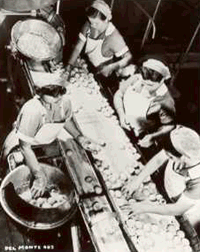
Photograph courtesy of History San José

Photo courtesy of National Historic Landmarks collection
The growth of post World War II suburban development in the valley caused the disappearance of the orchards. Sunnyvale, which in 1939 was described as "a quiet ranchers' trade center," with a population of 3,094, grew to a suburb with a population of over 107, 229 by 1990, a population rise of 10% in one decade (1980-1990). Santa Clara County was, by 2000, home to 1,682,585 and still growing. The city of Santa Clara, (1939 population 6,303), Mountain View, (1939 population 3,308) and other Santa Clara cities also grew to many times their 1939 population size. However, vestiges of the old orchards remained, throughout the county, and as late as 1970 San Jose was still classified as partly rural by the US census, although the city had a population of 443,950. By 1990 San Jose's population reached 782, 248 people, according to the US census, and was the 11th most populated city in the nation, surpassing San Francisco in population.
Santa Clara County's growing suburbs can be tied to nationwide trends. The advent of the automobile and larger freeways and highways helped in the creation of suburbs. By the 1920s a cultural reaction against Victorian architecture and the creation of the affordable bungalow also helped this trend, as the middle class could afford homes outside the cities. Already in the 1920s, suburban areas were growing at a faster rate than central cities and after World War II, the suburban population exploded nationwide. During the 1940s, core cities grew by an average of 14 percent while the suburbs grew by 36 percent. Returning World War II veterans, getting married and settling down produced a baby boom unprecedented in American history. Already by 1960 more metropolitan residents lived in the suburbs than in the central city, and by 1990 the majority of all Americans lived in suburban areas. With the shift from an agricultural county to a large suburban one, Santa Clara County was following national trends. Its next move, with the creation of Silicon Valley, would lead national trends in creating the computer revolution, which would sweep the nation and the world.

Photograph courtesy of NASA/AMES, Image A-21303, taken April 5, 1956
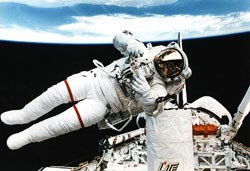
Photo Courtesy of NASA(SAFER) Simplified Aid for Eva Rescue Image # MSFC-00071 (MSFC) http://nix.nasa.gov/
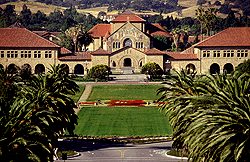
Photo courtesy of Stanford News Service/Linda A Cicero www.stanford.edu
In 1947, William Shockley, leading a Bell Labs team, invented the transistor. Shockley returned home to his native Palo Alto and created Shockley Transistor. Differences arose within the company over the choice between the use of two semiconducting materials--silicon and germanium. Shockley preferred germanium, but his eight engineers believed silicon to be the superior semiconducting material. They left Shockley in 1957, forming Fairchild Semiconductor in Mountain View. Fairchild was the first company to manufacture exclusively in silicon, and to mass manufacture a micro-sized device able to integrate large numbers of electrical "on-off" switching functions, which were stored in simple memory cells, all etched onto a silicon chip.
Journalist Don C. Hoefler first coined the term "Silicon Valley" to describe the region in a series of articles he wrote for Electronic News, a weekly industrial tabloid, in 1971. Also in 1971, Intel created the first microprocessor, the 4004-chip. The next step in the Silicon valley revolution occurred in March 1975, when the Homebrew Computer Club in Menlo Park was created by students with an interest in technology and a desire to experiment with building home computers. Steve Wozniak, a founding member, built a home computer from a cheap microprocessor, and showed it to his fellow club members, who included his friend Steve Jobs. Together, in Steve Job's garage in Cupertino, Wozniak and Jobs formed Apple Computer. By 1976 the first Personal Computer - Apple I, was offered from Apple Computer.In 1947, William Shockley, leading a Bell Labs team, invented the transistor. Shockley returned home to his native Palo Alto and created Shockley Transistor. Differences arose within the company over the choice between the use of two semiconducting materials--silicon and germanium. Shockley preferred germanium, but his eight engineers believed silicon to be the superior semiconducting material. They left Shockley in 1957, forming Fairchild Semiconductor in Mountain View. Fairchild was the first company to manufacture exclusively in silicon, and to mass manufacture a micro-sized device able to integrate large numbers of electrical "on-off" switching functions, which were stored in simple memory cells, all etched onto a silicon chip.
Journalist Don C. Hoefler first coined the term "Silicon Valley" to describe the region in a series of articles he wrote for Electronic News, a weekly industrial tabloid, in 1971. Also in 1971, Intel created the first microprocessor, the 4004-chip. The next step in the Silicon valley revolution occurred in March 1975, when the Homebrew Computer Club in Menlo Park was created by students with an interest in technology and a desire to experiment with building home computers. Steve Wozniak, a founding member, built a home computer from a cheap microprocessor, and showed it to his fellow club members, who included his friend Steve Jobs. Together, in Steve Job's garage in Cupertino, Wozniak and Jobs formed Apple Computer. By 1976 the first Personal Computer - Apple I, was offered from Apple Computer.
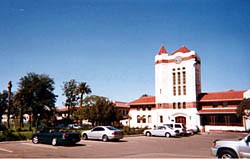
Photograph by Judith Silva, courtesy of the City of Santa Clara
Even after the recent dot.com crash, "about 4,000 IT-related companies located along Highway 101 from San Francisco to San Jose generate approximately $200 billion in IT-related revenue annually" reported Gregory R. Gromov, in The Roads and Crossroads of Internet History. Recently Sun Microsystems, an industry giant, renovated Agnews Insane Asylum, originally a series of buildings constructed in 1888 for the advanced and humane treatment of the mentally ill. Sun Microsystems invested $10 million in the restoration of key historic buildings on the property where it built its corporate headquarters and office/research and development space for more than 3,000 employees.
Silicon Valley's numerous inventions, scientific discoveries, adaptations, and developments placed Santa Clara County in the forefront of the information age. Ward Winslow's The Making of Silicon Valley records Santa Clara's contributions to civilization, including "Long Distance high-voltage transmission, the amplifying vacuum tube, the first commercial radio broadcast, long distance continuous-wave radio transmissions, mobile radio systems development, the klystron tube and microwave radar, electronic measuring devices, nuclear induction applications, the X-ray microscope, traveling-wave tube development, silicon crystal-growing, programmable handheld calculators, videotape and VCRs, development of the junction transistor, linear accelerators for particle physics research and cancer treatment." Other technical advances also occurred in the field of biotechnology, a new industry, springing from discoveries of gene-splicing and gene-cloning at the Bay Area Universities. The local four-year colleges and two-year community colleges met the demands for supplying high technology companies with engineers. San Jose University leads the field in supplying these industries with more engineer graduates then all other colleges combined.
Overall, Santa Clara County's scientific/commercial renaissance has, with justification, been compared to the earlier European renaissance. The creation of lasers, nuclear magnetic resonance, random access computer storage; disk drives, integrated circuits, personal computers, open-heart surgery, ink jet printing, gene-splicing and other wonders in such a short span of time has placed Santa Clara County firmly in history as a unique location whose creative energies have changed the world.
Much of the information for this article comes from editor Ward Winslow's draft of The Making of Silicon Valley. Santa Clara Valley Historical Association, 1995. Information for the 1945 growth of the county came from Hal Martin's article, "Building Code Aims Listed," in the front page of the San Jose Mercury Herald, 9 August 1945. Excellent online sources included Gregory R. Gromov's, History of Internet and WWW: The Roads and Crossroads of Internet History found at http://www.netvalley.com/intval.html. Another excellent source was Alexander Loudon's The History of Silicon Valley found at http://www.alexanderloudon.info/uploads/svhistory.pdf. Material for the history of suburban growth in the United States comes from the draft manuscript of Linda McClelland and David. L. Ames, Guidelines for Evaluating and Documenting Historic Residential Suburbs found at http://www.nps.gov/history/pub/nr/ameweb2.doc
